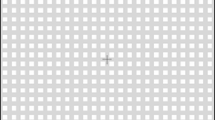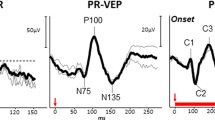Abstract
In this paper, we purpose a diagnostic procedure to identify the optic nerve disease from visual evoked potential (VEP) signals using an Artificial Neural Network (ANN). Multilayer feed forward ANN trained with a Levenberg Marquart backpropagation algorithm was implemented. The correct classification rate was 96.87% for subjects having optic nerve disease and 96.66% for healthy subjects. The end results are classified as healthy and diseased. Testing results were found to be compliant with the expected results that are derived from the physician’s direct diagnosis, angiography, VEP and pattern electroretinography. The stated results show that the proposed method could point out the ability of design of a new intelligent assistance diagnosis system.




Similar content being viewed by others
References
Heckenlively, J. R., and Arden, G. B., Principles and Practice of Clinical Electrophysiology of Vision. Mosby Year Book: United States of America, 1991.
Tasman, W., Duane's Foundations of Clinical Ophthalmology. Lippincott Williams and Wilkins: United States of America, 1992.
Vernon Odom, J., at all, Visual evoked potentials standard, Documenta Ophthalmologica, 2004 Kluwer Academic Publishers. Printed in the Netherlands, 108:115–123, 2004.
Maffei, L., and Fiorentini, A., Electroretinographic responses to alternating gratings before and after sectioning of the optic nerve. Science. 211:953, 1981.
Sivakumar, R., and Ravindran, G., Automatic discrimination of abnormal subjects using the visual evoked potential spectral components. J. Biomed. Biotechnol. 1:5–9, 2004.
Sivakumar, R., Ravindran, G., Muthayya, M., Lakshminarayanan, S. and Velmurughendran, C. U., Diabetic retinopathy analysis. J. Biomed. Biotechnol. 1:20–27, 2005.
Rutecka, A., et al. The study of PSVEP with dysthyroid optic neuropathy. In: 36th Symposium International Society for Clinical Electrophysiology of Vision. Hradce Kralove, Czech Republic; 1998: Abstracts.
Lisboa, P. J. G., Ifeachor, E. C., and Szczepaniak, P. S., Artificial Neural Networks in Biomedicine. Springer-Verlag: London, 2000.
Salvi, M., Dazzi, D., Pelistri, I., Neri, F., and Wall, J. R., Classification and prediction of the progression of thyroid-associated ophthalmopathy by an artificial neural network. Ophthalmology. 109(9):1703–1708, 2002.
Vuckovic, A., Radivojevic, V., Chen, A. C. N., and Popovic, D., Automatic recognition of alertness and drowsiness from EEG by an artificial neural network. Med. Eng. Phys. 24:349–360, 2002.
Tigges, P., Kathmann, N., and Engel, R. R., Identification of input variables for feature based artificial neural networks-saccade detection in EOG recordings. Int. J. Med. Inform. 45:175–184, 1997.
Güven, A., and Kara, S., Classification of electro-oculogram signals using artificial neural network. Expert Syst. Appl. 31(1):199–205, 2006.
Lipoth, L. L., Hafez, H. M. and Goubran, R. A., Elecroretinographical (ERG) Based Classification of Eye Diseases. Ann. Int. Conf. IEEE Eng. Med. Biol. Soc. 13(3):1991.
Kara, S., Güven, A., and Öztürk Öner, A., Utilization of Artificial Neural Networks in the Diagnosis of Optic Nerve Diseases. Comput. Biol. Med. 36(4):428–437, 2006.
Kara, S., and Güven, A., Training a Learning Vector Quantization Network Using the Pattern Electroretinography Signals. Comput. Biol. Med. 37(1):77–82, 2007.
Güven, A., and Kara, S., Diagnosis of the macular diseases from pattern electroretinography signals using artificial neural networks. Expert Syst. Appl. 30(2):361–366, 2006.
Kara, S., Güven, A., Okandan, M., and Dirgenali, F., Utilization of artificial neural networks and autoregressive modeling in diagnosing mitral valve stenosis. Comput. Biol. Med. 36(5):473–483, 2006.
Nguyen, H. T., Butler, M., Roychoudhry, A., Shannon, A. G., Flack, J., and Mitchell, P., Classification of diabetic retinopathy using neural networks, 18th Annual International Conference of the IEEE Engineering in Medicine and Biology Society: Amsterdam, 1548–1549, 1996.
Wright, I. A., and Gough, N. A. J., Artificial neural network analysis of common femoral artery Doppler shift signals: Classification of proximal disease. Ultrasound Med. Biol. 24(5):735–743, 1999.
Beale, R., and Jackson, T., Neural computing: an introduction. Bristol, UK: Institute of Physics Publishing, 1990.
Haykin, S., Neural networks: a comprehensive foundation. New York: Macmillan College Publishing Company Inc., New York, 1994.
Simpson, P. K., Artificial Neural Systems. Pergamon Press, 1989.
Long, W. J., Medical informatics: Reasoning methods. Artif. Intel. Med. 23:71–87, 2001.
Lynn, P. A., An introduction to the analysis and processing of signals. (2nd ed) London, UK: Macmillan, 1982.
Acknowledgement
This project was supported as Post-Graduate Education and Research Project by Erciyes University (Project no: FBT-04-27).
Author information
Authors and Affiliations
Corresponding author
Rights and permissions
About this article
Cite this article
Kara, S., Güven, A. Neural Network-Based Diagnosing for Optic Nerve Disease from Visual-Evoked Potential. J Med Syst 31, 391–396 (2007). https://doi.org/10.1007/s10916-007-9081-0
Received:
Accepted:
Published:
Issue Date:
DOI: https://doi.org/10.1007/s10916-007-9081-0




